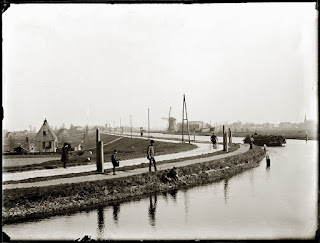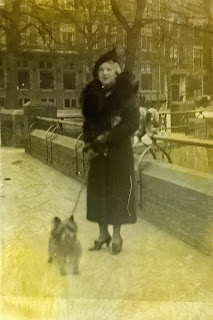Where there's a will ....
Where there's a will, there's a .... fill in the blanks is the prompt for week 9. It could be an actual document like a last will and testament. In my family research so far I have not found one and I was relieved to receive this very timely blog post from Dutch genealogist Yvette Hoitink, Dutch Ancestors left few last wills.
So I'm going with "where there's a will, there's a way". My Dutch grandmother Bé Blomberg-Lawerman liked to say "wil niet is dood en kan niet ligt ernaast" - "will not is dead and cannot lies beside it". Off I'd go again, grumbling, to do my homework; she wasn't buying my latest excuse.
So now I'm delving into the memories of family stories that tell of determination and ingenuity in the face of adversity.
I remember aunt Tippy, she would stay on holidays with my grandfather as did our family when we returned on leave from the East. She was a kind, gracious, elegant lady, who taught me a few words of Norwegian (she lived in Oslo).
When Java (Dutch East Indies), was occupied by Japan in 1942, my grandfather Rein Peelen was taken to the prison camp Kesilir, located on the very Eastern tip of Java, on 8 August 1942 (p. 36, A Wandering Tulip, the Story of Gretel Peelen by Ceris Arns).
As I recall from my mother's story, the wives and mothers were allowed to visit once a month and of course my grandmother Meta Peelen-Reith packed as much food and other useful items as she could manage. She had to travel by train from their home in Salatiga (Central Java) and Google Maps shows it as a car journey of 13-16 hours, so a long day, if not two days. Kesilir is a district, not a place and was located near Banyuwangi, East Java. The cover of the book Java 1942-1945 Kampschetsen uit: Kesilir, Bajnoe Biroe, Tjikoedapateuj 15e bat. in Bandoeng, in my family archive shows its approximate location.
Being the daughter of a customs officer, Meta knew a thing or two about smuggling. She emptied a bottle of brandy into an old Ketjap Manis (sweet soy sauce) bottle and then smeared the sauce around the opening and the cork. When questioned on arrival at the camp about the contents of the bottle she would pull of the cork and hold it up for them to smell. That's how my grandfather and his camp mates enjoyed a little clandestine brandy.
Camp Kesilir was unusual. It was first established in 1926 by the Indo-Europees-Verbond (Indo-European Association) as the location of an agrarian settlement to be populated by mostly European men who had married and had children with an Indonesian woman. Poverty prevailed in the area, but Kesilir offered a reasonable standard of living. The families leased a parcel of land and were given a brief course in farming.
When Japan occupied Java, soldiers were made prisoners of war and almost all civil servants were imprisoned. Unemployment was high, wages were not paid, bank funds were confiscated and thousands were left destitute. Normal life had ground to a halt.
Japanese Commander Imamura had the task to implement an orderly plan of internment. He chose Kesilir as the destination to which all Europeans were to be deported. It was intended to be a Dutch self governing colony. He appointed J. G. Wackwitz, from the Handelsvereniging Amsterdam in Soerabaya to lead the project. As soon as he was appointed Wackwitz lodged a protest and pointed out that the area that was chosen was very unsuitable to the needs of around 70,000 individuals - the approximate number of Europeans at the time. There was a shortage of water and it was situated in a malaria district. Nevertheless Imamura persisted and Kesilir was very quickly made ready to receive the first prisoners. From July 1942 to February 1943 Kesilir was a colony which meant that wives and mothers could visit once a month. After February 1943 it became a prisoner of war camp, meaning the end of these visits and a few months later it was decided to close Kesilir. The war was now going badly for the Japanese and they feared that Kesilir could become a target for the allied forces to liberate the prisoners. In August 1943, 3000 men were moved to Banjoe Biroe and Tangerang. (Kampschetsen uit: Kesilir, Bajnoe Biroe, Tjikoedapateuj 15e bat. in Bandoeng. p. 8. 9.10)
My father had also been imprisoned in Kesilir and he said it was in hindsight the best of the camps, because they could at least grow their own food and they had more space.
.
The caption for this sketch in the publication Java 1942-1945 explains that compared to Camp Banjoe Biroe, inmates had more space and more personal belongings, as well as mosquito nets. They had made the petroleum and coconut oil lamps themselves.
The Japanese had banned any paper and pens. That so many sketches, portrait, notes and the like exist from this period is a testament to "where there's a will, there's a way".
So I'm going with "where there's a will, there's a way". My Dutch grandmother Bé Blomberg-Lawerman liked to say "wil niet is dood en kan niet ligt ernaast" - "will not is dead and cannot lies beside it". Off I'd go again, grumbling, to do my homework; she wasn't buying my latest excuse.
So now I'm delving into the memories of family stories that tell of determination and ingenuity in the face of adversity.
 |
| Julie Mathilde Peelen (Tippy) from the family archive. Image by Frensdorf-Hoeland Phot. |
There is the story of my great-aunt Tippy (Julie Mathilde Peelen), who was deserted by her husband in war-torn Berlin during the First World War. She had to somehow find a way to survive. As told in a family history publication : "She was left with two little children and no money. There was also hardly any food; Tip started to smoke from desperation, to not feel the hunger and so she could give the food to her children, but she became so ill that she staggered with them to a hospital in Berlin. This was overflowing with wounded officers and they had no room for her, but a young captain, offered her his room and took care of the children. They married in 1921, after she had had many operations on her stomach. "
(De Familie Scherius, by V.P. Loeliger Salomonson, p. 119)I remember aunt Tippy, she would stay on holidays with my grandfather as did our family when we returned on leave from the East. She was a kind, gracious, elegant lady, who taught me a few words of Norwegian (she lived in Oslo).
When Java (Dutch East Indies), was occupied by Japan in 1942, my grandfather Rein Peelen was taken to the prison camp Kesilir, located on the very Eastern tip of Java, on 8 August 1942 (p. 36, A Wandering Tulip, the Story of Gretel Peelen by Ceris Arns).
As I recall from my mother's story, the wives and mothers were allowed to visit once a month and of course my grandmother Meta Peelen-Reith packed as much food and other useful items as she could manage. She had to travel by train from their home in Salatiga (Central Java) and Google Maps shows it as a car journey of 13-16 hours, so a long day, if not two days. Kesilir is a district, not a place and was located near Banyuwangi, East Java. The cover of the book Java 1942-1945 Kampschetsen uit: Kesilir, Bajnoe Biroe, Tjikoedapateuj 15e bat. in Bandoeng, in my family archive shows its approximate location.
 |
| Map showing location of Camp Kesilir on Java. From: Java 1942-1945 Cover |
Being the daughter of a customs officer, Meta knew a thing or two about smuggling. She emptied a bottle of brandy into an old Ketjap Manis (sweet soy sauce) bottle and then smeared the sauce around the opening and the cork. When questioned on arrival at the camp about the contents of the bottle she would pull of the cork and hold it up for them to smell. That's how my grandfather and his camp mates enjoyed a little clandestine brandy.
Camp Kesilir was unusual. It was first established in 1926 by the Indo-Europees-Verbond (Indo-European Association) as the location of an agrarian settlement to be populated by mostly European men who had married and had children with an Indonesian woman. Poverty prevailed in the area, but Kesilir offered a reasonable standard of living. The families leased a parcel of land and were given a brief course in farming.
When Japan occupied Java, soldiers were made prisoners of war and almost all civil servants were imprisoned. Unemployment was high, wages were not paid, bank funds were confiscated and thousands were left destitute. Normal life had ground to a halt.
Japanese Commander Imamura had the task to implement an orderly plan of internment. He chose Kesilir as the destination to which all Europeans were to be deported. It was intended to be a Dutch self governing colony. He appointed J. G. Wackwitz, from the Handelsvereniging Amsterdam in Soerabaya to lead the project. As soon as he was appointed Wackwitz lodged a protest and pointed out that the area that was chosen was very unsuitable to the needs of around 70,000 individuals - the approximate number of Europeans at the time. There was a shortage of water and it was situated in a malaria district. Nevertheless Imamura persisted and Kesilir was very quickly made ready to receive the first prisoners. From July 1942 to February 1943 Kesilir was a colony which meant that wives and mothers could visit once a month. After February 1943 it became a prisoner of war camp, meaning the end of these visits and a few months later it was decided to close Kesilir. The war was now going badly for the Japanese and they feared that Kesilir could become a target for the allied forces to liberate the prisoners. In August 1943, 3000 men were moved to Banjoe Biroe and Tangerang. (Kampschetsen uit: Kesilir, Bajnoe Biroe, Tjikoedapateuj 15e bat. in Bandoeng. p. 8. 9.10)
My father had also been imprisoned in Kesilir and he said it was in hindsight the best of the camps, because they could at least grow their own food and they had more space.
.
 |
| Sketch interior of a hut in Kesilir from publication Java 1942-1945 |
The caption for this sketch in the publication Java 1942-1945 explains that compared to Camp Banjoe Biroe, inmates had more space and more personal belongings, as well as mosquito nets. They had made the petroleum and coconut oil lamps themselves.
The Japanese had banned any paper and pens. That so many sketches, portrait, notes and the like exist from this period is a testament to "where there's a will, there's a way".



What family stories...thank you for sharing. Aunt Tippy's portrait is beautiful.
ReplyDeleteThank you. Indeed a treasured portrait.
DeleteSo interesting and a lovely photo
ReplyDelete